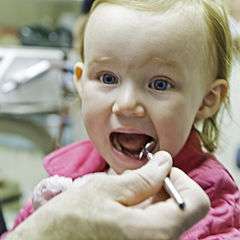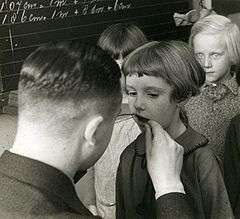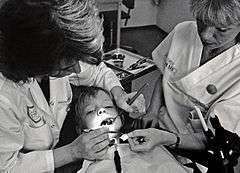Pediatric dentistry
Pediatric dentistry (formerly pedodontics in American English or paedodontics in Commonwealth English) is the branch of dentistry dealing with children from birth through adolescence.[1] The specialty of pediatric dentistry is recognized by the American Dental Association,[2] Royal College of Dentists of Canada,[3] and Royal Australasian College of Dental Surgeons.[4]



Pediatric (also paediatric or pædiatric) dentists promote the dental health of children as well as serve as educational resources for parents. It is recommended by the American Academy of Pediatric Dentistry (AAPD) and the American Academy of Pediatrics (AAP) that a dental visit should occur within six months after the presence of the first tooth or by a child's first birthday. The AAPD has said that it is important to establish a comprehensive and accessible ongoing relationship between the dentist and patient – referring to this as the patient's "dental home".[5] This is because early oral examination aids in the detection of the early stages of tooth decay. Early detection is essential to maintain oral health, modify aberrant habits, and treat as needed and as simply as possible. Additionally, parents are given a program of preventive home care (brushing, flossing and fluorides), a caries risk assessment, information on finger, thumb, and pacifier habits, advice on preventing injuries to the mouth and teeth of children, diet counseling , and information on growth and development.
Education
Pediatric dentistry is one of the ten dental specialties recognized by American Dental Association. Other specialties include dental public health, endodontics, oral and maxillofacial pathology, oral and maxillofacial radiology, oral and maxillofacial surgery, orthodontics and dentofacial orthopedics, periodontics, and prosthodontics.
The first step would be obtaining a college degree in biomedical science, health science, or social science. While in college, one can explore the profession by shadowing in a pediatric dental office or children hospital, or by working on academic research that studies oral health of children.
Second step would be attending a dental school for 4 years of education and training. One can graduate with Doctor of Dental Surgery (DDS) or Doctor of Dental Medicine (DMD). Both degrees are equivalent and involve the same training. It just depends on the specific school one goes to. During the first two years of dental school, dental students will take didactic classes on biomedical sciences and learn hand skills(dental procedures) in a pre-clinical laboratory setting. Third and fourth year of dental school focus on clinical care under the supervision of an attending faculty who is a licensed dentist. Before graduating, all dental students must pass National Board Dental Examination part I and part II, as well as clinical skill exams (e.g., ADEX, WREB, etc) to become a licensed general dentist.
In order to specialize in pediatric dentistry, one can seek additional training in an accredited postgraduate residency program.[6] Pediatric dentistry residency program can be 24 months or more in length. At the end, resident dentists are awarded a certificate in pediatric dentistry with or without a master's degree depending on the program they attend. Specialized training covers all aspects of oral health care from infancy through adolescence, encompassing behavior management, preventive dentistry, restorative dentistry, sedation dentistry, oral trauma management, interceptive orthodontics, oral medicine and pathology. A large part of residency training is spent on treating pediatric patients in a dental clinic or hospital operation room.[7]
Following successful completion of post-graduate training, one becomes Board eligible for the American Board of Pediatric Dentistry(ABPD) examination. The first part of the Board exam is a written exam. Once passing the written exam, one moves on to the second part, which is an oral examination testing on clinical knowledge and skills. Successful completion of board certification results in Diplomate status in the American Board of Pediatric Dentistry that allows one to practice as a Board-certified pediatric dentist.
Job Description
Responsibilities of a pediatric dentist include:
- Diagnose oral diseases.
- Promote oral health for children and adolescents(healthy, sick or those with disabilities)
- Formulate treatment plans to restore oral health of pediatric patients.
- Interpret x-rays and diagnostic tests.
- Monitor growth and development of the teeth and jaws.
- Correct malocclusion through interceptive orthodontic treatment.
- Perform surgical procedures on the teeth, bone and soft tissues of the oral cavity.
- Treat dental caries and odontogenic infection.
- Manage dental trauma, including fractured, displaced, and knock-out teeth.
- Treat pediatric patients under various stages of sedation(minimal, moderate, or deep).
One of their main concerns is tooth decay prevention. Not only do they work with the teeth, pediatric dentists also look at the gums, throat muscles and nervous system of the head, neck and jaw, the tongue, and salivary glands. They do this to check for pathology and other anomalies.[8] Another duty of theirs is to test for oral cancer and perform biopsies, if needed.[8]
Career Outlook
It has been reported by the U.S. Bureau of Labor Statistics job growth for pediatrics dentist will increase about 20% from 2014-2024. The median salary for a pediatric dentist is about $175,000 a year. As of Oct 6, 2019, the average annual pay for a Pediatric Dentist in the United States is $245,671 a year. Most pediatric dentists owns their own private practices or work as an associate. There is also an option for them to work at dental schools to teach and train pediatric residents.[7]
See also
- Dentistry for babies
- School health services
- Special needs dentistry
- Hall Technique
- Minnie Evangeline Jordon
- Pediatric crowns
References
- "What is a Pediatric Dentist?". HealthyChildren.org. 2013-11-05. Retrieved 2014-08-01.
- "Specialty Definitions". Ada.org. Retrieved 2014-08-01.
- "RCDC – Specialties". Rcdc.ca. Retrieved 2014-08-01.
- Paediatric dentistry (requires log-in)
- "Definition Of A Dental Home" (PDF). AAPD. June 3, 2013. Retrieved 2013-06-03.
- "How to Become a Pediatric Dentist". Doctorly.org. Retrieved 2017-03-27.
- "Pediatric Dentistry Careers: Job Options and Education Requirements". Study.com. Retrieved 2017-03-29.
- "Dentists: Doctors of Oral Health". www.ada.org. Retrieved 2017-04-03.
External links
Organizations